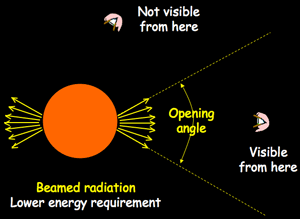Gamma Ray Burst Energies

Gamma ray bursts (GRBs) are the most violent and energetic explosions in the Universe. For the short period of time they are visible (generally less than 30 seconds), even comparitively weak GRBs output more energy than the Sun has emitted so far in its 5 billion year lifetime. Although there is growing concensus that the progenitors of at least some GRBs are extremely energetic supernovae called hypernovae, the exact mechanism of the explosion and how the energy is produced and emitted is still hotly debated.
In 1997 it was established that GRBs occupy the furthest reaches of the Universe and astronomers were immediately faced with the dilemma of how to produce so much energy in such a short period of time. They began with the assumption that GRBs emit their radiation isotropically (equally in all directions) much as a supernova does, but quickly decided that such massive energy production was physically unfeasable. If the radiation was emitted in this way, 3×1047 Joules of energy was required in less than a minute (the equivalent of 100,000 supernovae going off simultaneously) for the most energetic bursts!

To alleviate this problem, theorists suggested that rather than being emitted equally in all directions, the radiation from GRBs is beamed into two narrow cones with opening angles of only a few degrees. This reduced the energy of GRBs to a level similar to that observed for energetic supernova explosions, but also meant that we would only observe a GRB if the beamed emission was directed towards the Earth.
Although this means that we are potentially seeing only a small fraction of the total number of GRBs (some estimates suggest that for every GRB we observe, there are 500 others we do not see), we no longer need to evoke exotic physics to account for their extreme energies. A hypernova explosion can account for the energy produced, and there is now convincing evidence that hypernovae are assocated with at least some GRBs.
Study Astronomy Online at Swinburne University
All material is © Swinburne University of Technology except where indicated.

